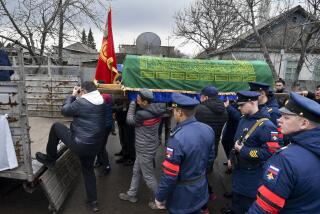SOVIET UNION : Dreams Build as Homes Rise at Czar Village : The Kazakhstan development is the first real step toward property rights for individuals.
- Share via
KARAGANDA, Soviet Union — Rising out of the Kazakhstan steppe just southeast of this Central Asian coal mining city is a slice of the American dream: a private housing development.
Although the land remains state-owned and supervised, the roughly 1,000 houses under construction here are the property of private Soviet citizens, who, much like millions of homeowners in the West, have taken out 25-year mortgages from the local bank to fulfill one of the most bourgeois of hopes.
Just how much the idea breaks with the country’s Communist past is heralded in the development’s name: Czar Village.
While it is unlikely that Czar Village marks the beginning of a trend that will eventually turn the former Soviet Union into a nation of private homeowners, it signals the depth of commitment on the part of the country’s more progressive leadership to implement real change.
The program also breaks important ground by getting banks accustomed to the idea of issuing long-term loans to individuals for personal investment.
A two-story, three-bedroom house complete with garage runs from 80,000 to 120,000 rubles ($2,500 to $3,700). Because the country’s lethargic, centralized supply system suffers from shortages of construction materials, some homeowners choose to buy a house through their employer--usually one of the area’s state-run mining enterprises--since such organizations have greater pull.
Local political leaders here say Czar Village, coupled with two smaller private housing projects on the city’s southern fringe, is the idea of Kazakh President Nursultan A. Nazarbayev, who has emerged as one of the country’s most influential voices for change.
The decision on private housing came two years ago as part of a strike settlement package with local coal miners angered over housing conditions that force many families to double up in dilapidated, multistory apartments.
For anyone who has viewed Karaganda, it is easy to sympathize with the miners.
A creation of Stalin’s forced industrialization of the 1930s, Karaganda was transformed by communism’s brave-new-world planners from a small Kazakh village into a city of more than 500,000 to tap the area’s rich coal seams. They imported Russian laborers, built high-rise apartments to house them and sent them underground into the mines, some of which were bored directly under the city.
The result produced a lot of coal and an urban planning catastrophe.
In what Ludmilla Djarkova, the civil engineer in charge of construction for the local Department of Mines, modestly called a “mistake,” the city’s original planners forgot to account for the ground sinkage that invariably occurs in mining areas. By the 1960s, Karaganda started, quite literally, collapsing.
Today, much of the housing in the central areas has been torn down; water, gas and electricity lines rupture, and the main road north from the city detours around a large bridge that has sunk so low that it cannot be used.
“About half the population has had to be rehoused,” said Djarkova. “It’s a big problem.”
Looking for a solution as radical as the problem, individual private housing became the answer.
It has proved popular.
According to Nina Layev, manager of Soviet State Bank No. 2103 in Karaganda, 20 million rubles ($650,000) in housing mortgages have so far been issued by her branch, and there is a backlog of 262 loan applications waiting to be processed.
Loans, she says, are guaranteed by employers. To make sure the money isn’t diverted elsewhere, the mortgage money is released in stages.
Although miners are among the best-paid Soviet workers, it’s still a battle for most to scrape together the down payment, which can be 50%.
More to Read
Sign up for Essential California
The most important California stories and recommendations in your inbox every morning.
You may occasionally receive promotional content from the Los Angeles Times.













